MARIANI’S
Virtual
Gourmet
October
19, 2014
NEWSLETTER
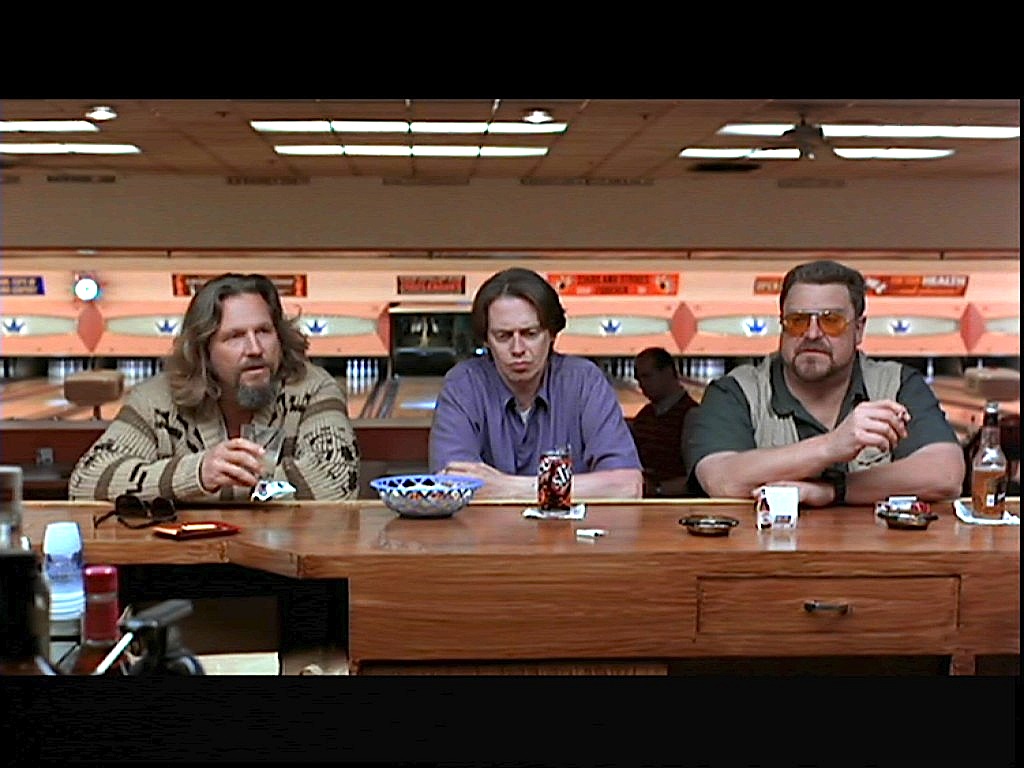
❖❖❖
IN THIS ISSUE
FORT LAUDERDALE GROWS UP
By John Mariani
NEW YORK CORNER
Barchetta
By John Mariani
NOTES FROM THE WINE CELLAR
Why Bordeaux Matters
By John Mariani
❖❖❖
FORT LAUDERDALE GROWS UP
By
John
Mariani
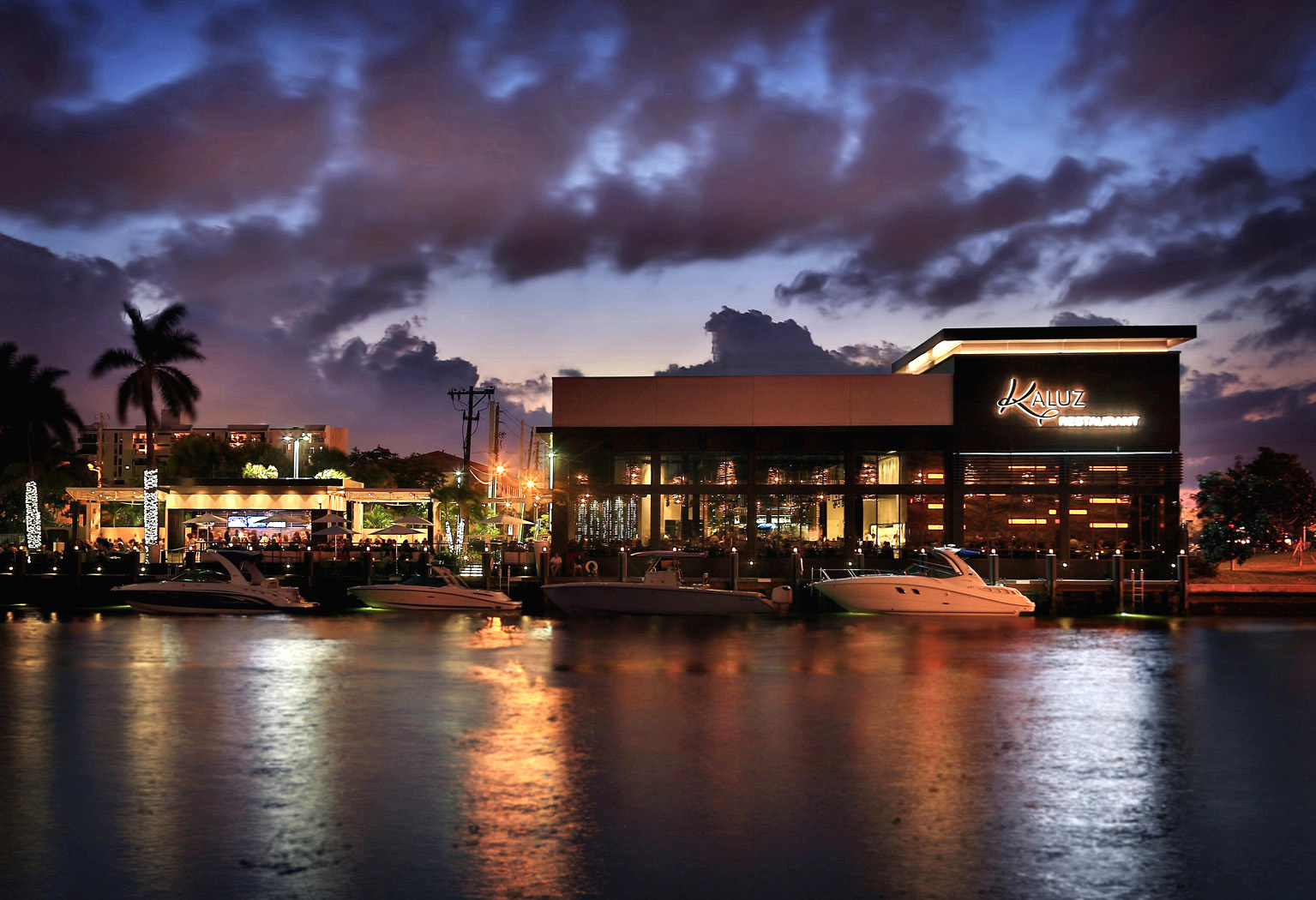
Kaluz Restaurant, Fort
Lauderdale
Fort Lauderdale may never shake its
image as the most iconic Spring Break city after
being portrayed in Cinemascope in the 1960 movie
“Where the Boys Are,” in which Connie Francis,
Yvette Mimieux, Dolores Hart, Jim
Hutton, George Hamilton and other young stars spend
90 minutes trying to succeed in, or ward off, sexual
conquest.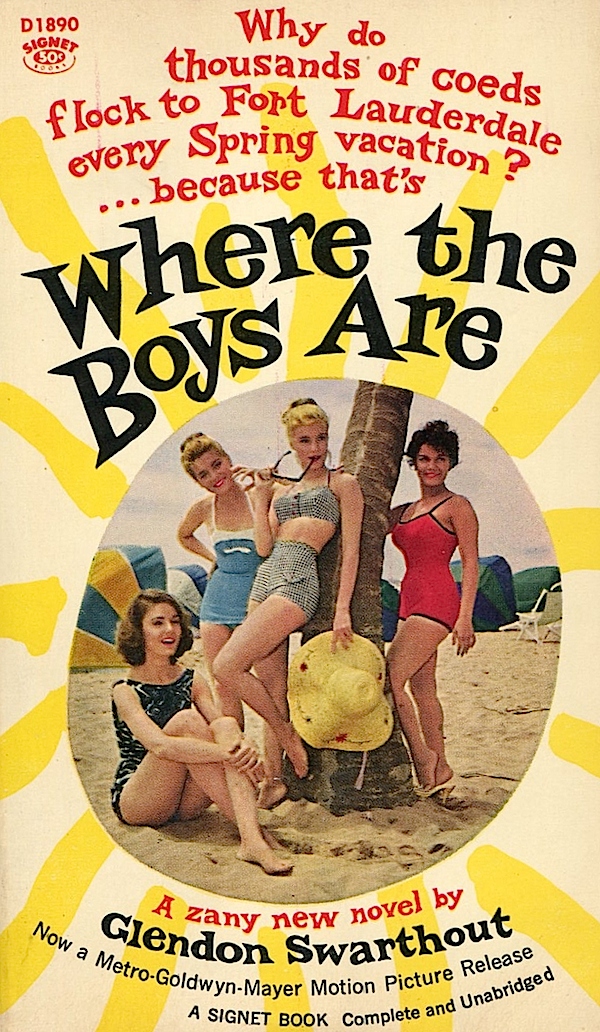
Although the city never exploited its nefarious
image, it made money from it while enduring the
annual debaucheries on its beaches and in its
motels. But,
as the “scene” got more and more decadent with each
succeeding decade, the local leaders and police
began cracking down on the excesses, while trying to
create a Fort Lauderdale that was a far more
inclusive vacation destination for grown-ups and
families the other fifty weeks of the year.
Indeed, anyone who visits Fort Lauderdale other than
during Spring Break will find a city intent on
boosting its arts and culture, which range from the
burgeoning Museum
of Art to the 35-acre Bonnet House
Museum & Gardens. The strip
known as Las Olas makes for a good stroll for food
and boutiques, and there’s always the fine white
sand beach and the blue water beyond. The IGFA Fishing Hall of
Fame & Museum is here, too, and a
whole lot of gastropubs and breweries, like the
cavernous Funky Buddha Brewery Tap Room, which you
may tour.
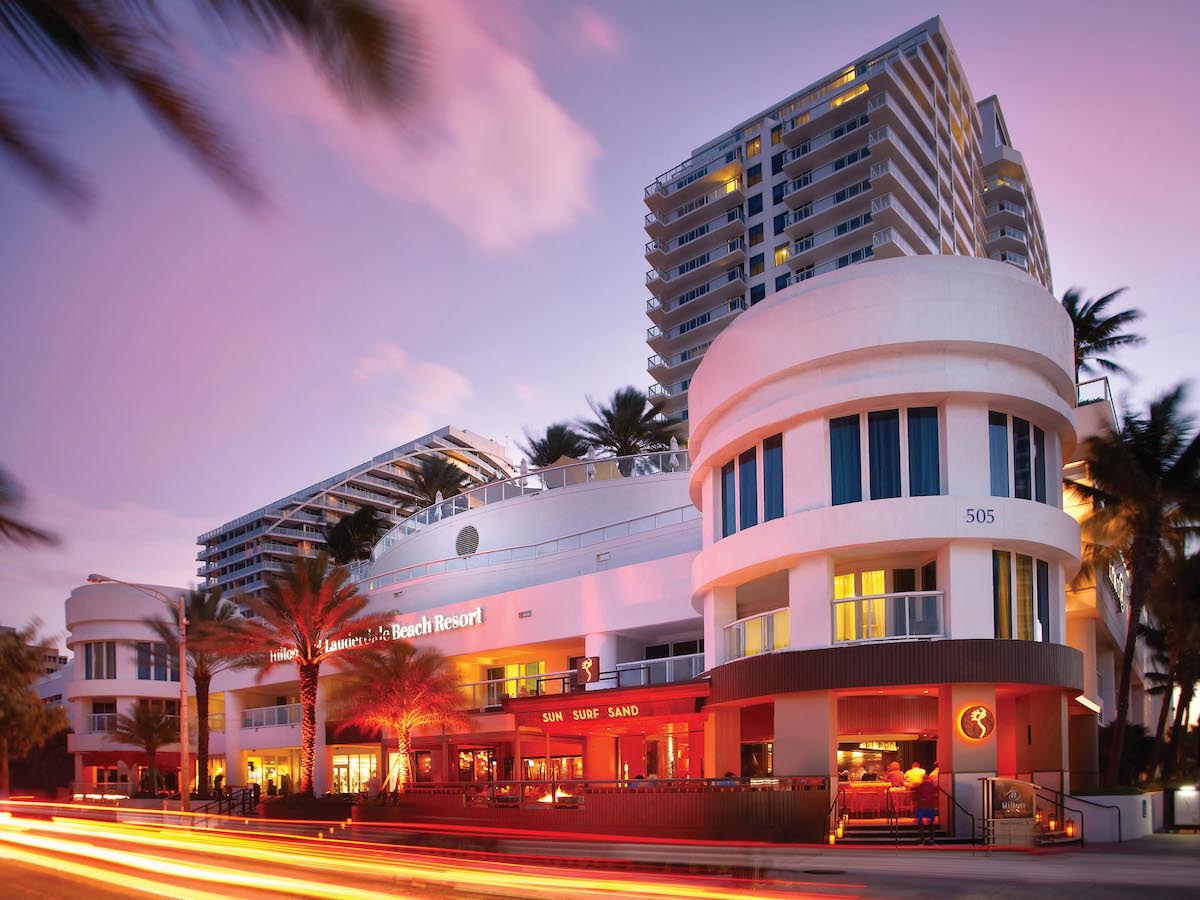 On
a recent trip to Fort Lauderdale, I tried to find
various aspects of the city’s gastronomy, starting
with checking into the Hilton
Fort Lauderdale Beach Resort at North
Beach (left), which manifests a judicious
balance of luxury and relaxed style, all its rooms
with balconies overlooking the ocean.
On
a recent trip to Fort Lauderdale, I tried to find
various aspects of the city’s gastronomy, starting
with checking into the Hilton
Fort Lauderdale Beach Resort at North
Beach (left), which manifests a judicious
balance of luxury and relaxed style, all its rooms
with balconies overlooking the ocean.
It also has one of the best restaurants in Florida,
which should not come as a surprise, since upscale
hotel chains in the U.S. have really put their money
where their mouths are, at least in their premier
restaurants. Here
it is called S3, whose name derives from
“Sun, Sea and Sand.” The restaurant is part in and
part outdoors, with a fire pit on the patio. The menu
consists of what used to be called Fusion Cuisine,
but it also draws on the ideas of Flor-ibbean food
cultures, so that you might begin with some stellar
sushi and sashimi (below) with guacamole
components, an array of fanciful specialty rolls (below)—try
the Red Dragon with crispy shrimp, crab, avocado,
mango and tobiko--or goat’s cheese croquettes
crusted with almonds and served with red chili
guava.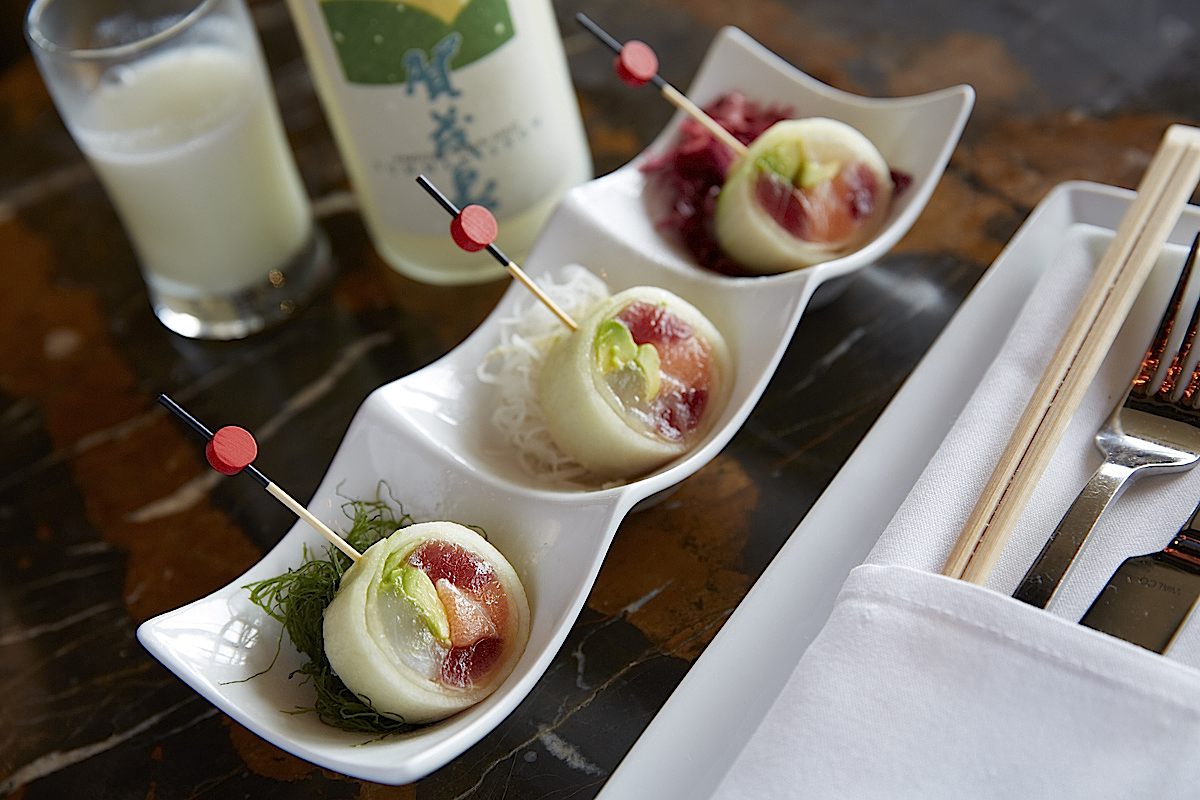
This is a nosher’s menu, so bring friends and share
dishes like the paella-style seafood heaped with chorizo,
shrimp, clams, mussels and scallops with fregola
grain, or the Vietnamese chicken wings, a terrific,
zesty item with peanuts and a green papaya salad. Ricotta
gnocchi in a fennel leek fondue with peas and
shiitakes was a canny rendering, and shortribs with
smoked calabaza puree showed a good deal of spark
and imagination. The baked macaroni and cheese
(below) needs no imagination, just a big fork
and spoon.
From the wood-fired oven comes a smoky,
coffee-rubbed skirt steak, nicely chewy and very
juicy, with yucca and hot chimichurri, A lot of
people will spot the brisket sliders with mustard
BBQ sauce and chow chow on the menu and just go for
it.
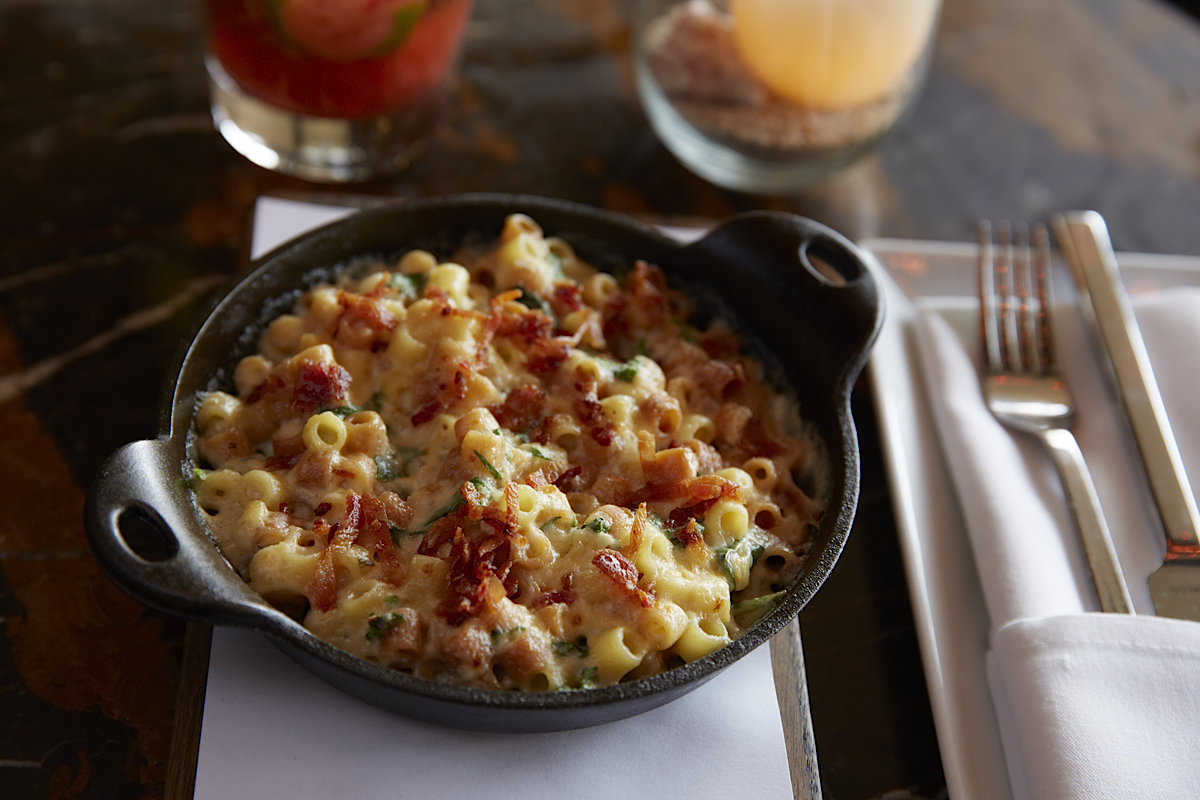 As I said, you
could just order plenty of these small plate dishes
and be very happy with cold beer or a good wine, but
there are also large plates, like marinated lamb
chops with chickpeas, tomato, feta, olives and lemon
or a beef ribeye with a cippollini mushroom
ragôut, that show a Mediterranean drift.
As I said, you
could just order plenty of these small plate dishes
and be very happy with cold beer or a good wine, but
there are also large plates, like marinated lamb
chops with chickpeas, tomato, feta, olives and lemon
or a beef ribeye with a cippollini mushroom
ragôut, that show a Mediterranean drift.
Another of Fort
Lauderdale’s more lavish restaurants is the huge Kaluz,
set on the Intracoastal Waterway. The glass-walled
restaurant, with Argentine owners, draws a glamorous
crowd on the prowl, starting at the patio bar. In fact,
you can sidle up to the mooring side of the
restaurant, hop off your yacht and join the throng
of women for whom a well-earned tan is as requisite
stiletto heels.
Kaluz tries hard to be everything for everybody. You
want sandwiches?
There are several burgers and a chicken club.
Salads? Eight of them, including Thai noodle and
shrimp with coconut and peanuts. The seared tuna
sushi (below) is very good and generously
proportioned (market price).
They serve first-rate Bell & Evans roast chicken
with herbs and parmesan mashed potatoes ($17), so
why do they buy inferior Australian rack of lamb? And,
while the NY strip steak ($39)—a 16-ounce Sterling
Silver Premium Choice--had plenty of beefy flavor,
and a loaded baked potato,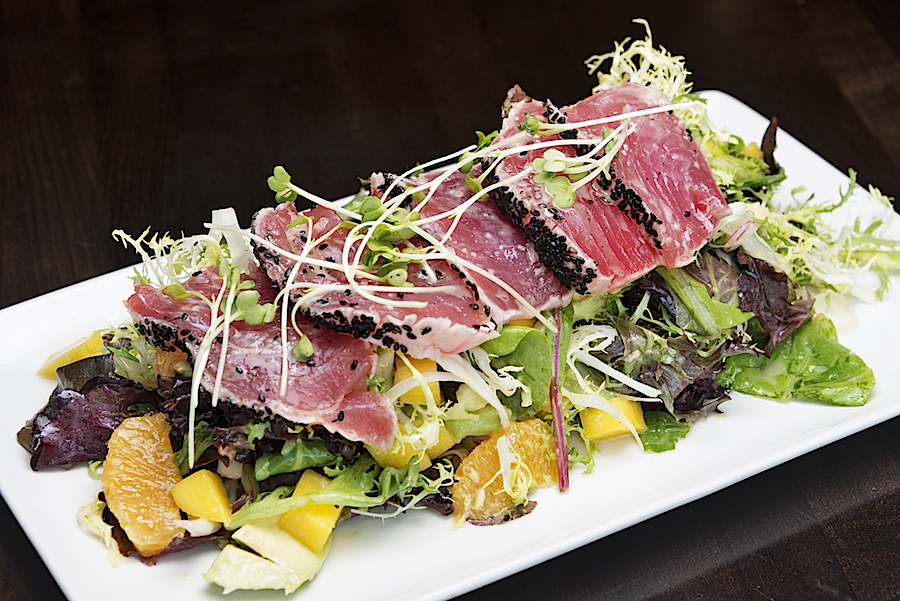 there’s little to be said for the flavorless and
boneless 14-ounce prime rib. The Bar
Harbor crabcake ($32) with remoulade was good and
generous enough, but the advertised “jumbo lump
crab” was in short supply in the cake I had. The best
of the desserts, as you might hope in Florida, is
the Key lime pie ($8)with a delicious graham cracker
and pecan crust.
there’s little to be said for the flavorless and
boneless 14-ounce prime rib. The Bar
Harbor crabcake ($32) with remoulade was good and
generous enough, but the advertised “jumbo lump
crab” was in short supply in the cake I had. The best
of the desserts, as you might hope in Florida, is
the Key lime pie ($8)with a delicious graham cracker
and pecan crust.
There’s a modest wine list, but the “Captain’s List”
is where the most interesting, and expensive, bottles
reside.
At the opposite end of the city’s diningscape is Hot & Soul,
a small storefront—and one that’s very easy to miss
within a strip mall—that since opening in 2013 has
really won the hearts and appetites of the locals. But now
the word is out among visitors, so owners Christy
and Mike Samoy (below) work very hard to meet
expectations with a big menu appended by blackboard
specials.
Hot & Soul is the kind of place where you get
plenty of both, and the soul comes from the fervid
commitment of the couple to cook as they like
without cooking anything people won’t crave after
trying it.
 My
friends and I ate from all over the menu and, had we
not filled up so greedily on the “Gnaughty Gnocchi”
with oxtail meat, tomatoes, basil and assertive
pecorino, and the hearty Gumbo Yumbo of chicken and
hot andouille with rice (below), we might
have eaten everything on the menu.
My
friends and I ate from all over the menu and, had we
not filled up so greedily on the “Gnaughty Gnocchi”
with oxtail meat, tomatoes, basil and assertive
pecorino, and the hearty Gumbo Yumbo of chicken and
hot andouille with rice (below), we might
have eaten everything on the menu.
The
Manchego cheese mushroom toast with sherry cream was
a delight, and a simple salad was as refreshing as
any I’d had last summer—Bibb lettuce, arugula,
tomatoes then at their peak, sweet onion, hearts of
palm and a sherry mustard vinaigrette.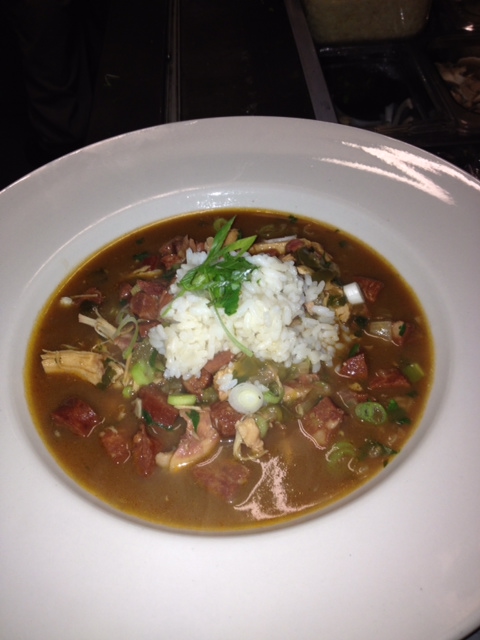
I also loved the Holay Mole made with pork shoulder,
red rice, pinto beans and a finely shredded
jalapeño slaw.
We forced ourselves to try two wonderful
desserts—dulce de leche custard with candied
cashews, caramel toast, and banana jam and dark
chocolate pistachio and sea salt bark drizzled with
extra virgin olive oil.
Hot & Soul delivers on all that it promises,
which seems at first modest—as are the two
idiosyncratically decorated rooms—but the food takes
a lot of skill, a lot of creativity and a whole lot
of soul.
To say O-B House is
a Fort Lauderdale mainstay is to do the food and
ambiance of this breakfast place a great injustice. For it’s
easy enough for people to slouch into any number of
places for eggs and pancakes, but when you walk
through the door of O-B and you meet the owner and
staff, who even early in the morning seem pumped up
with Florida sunshine, you know this is a place
where you’ll want to make friends.
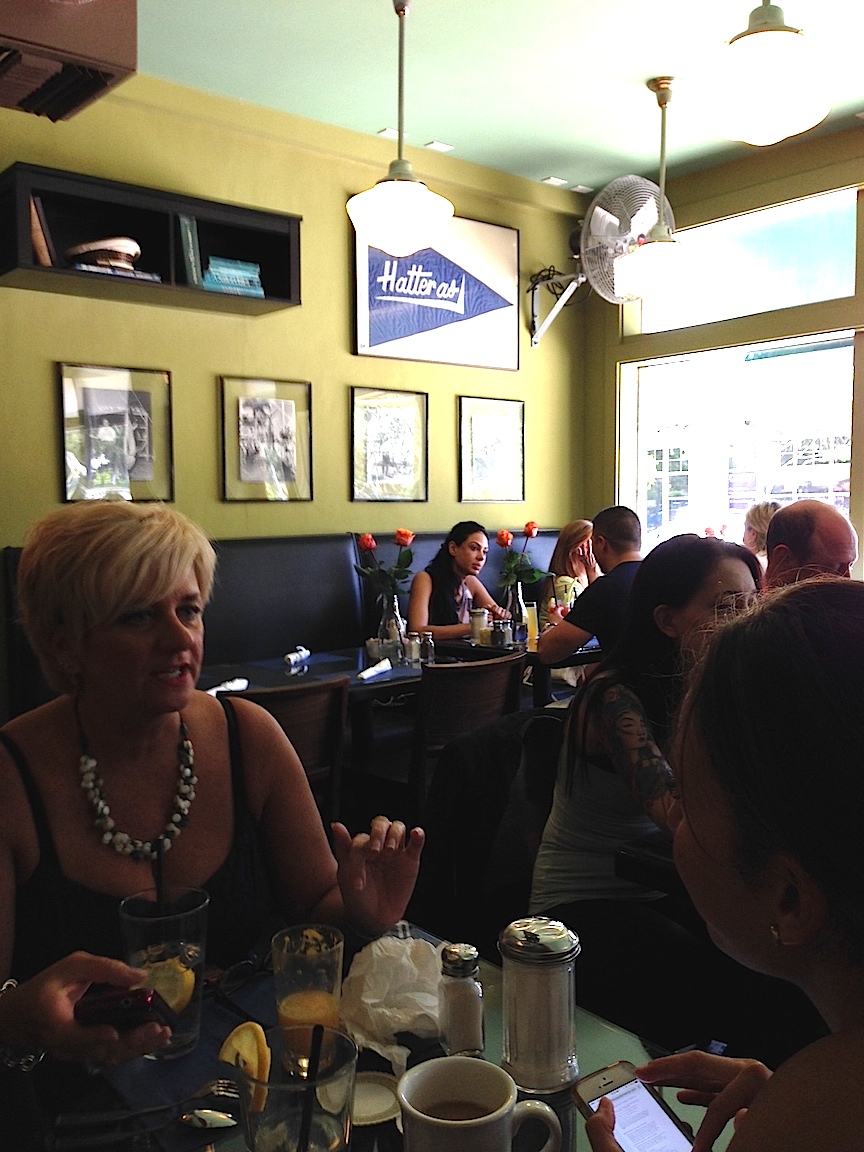 The maritime
décor in what is a 1925 house, the rich
colors, and the conviviality of the room, ringing
with the sound of people having a very good time, is
the backdrop for dishes you really can’t find
anywhere else.
The coffee is good and the cups big. The
ingredients are obviously the finest owner Rodney
Eli, Kansas born, can obtain. Its milk is not
homogenized, so it retains the cream, on the top;
the bread is made for them right down the block;
sausage is made in-house; eggs come from free-range
chickens; the maple syrup is from Vermont, costing
$70 a gallon.
So prices are higher than at an IHOP or a
Waffle House, but O-B’s food is worth every extra
penny, especially Chef Aaron Johnson’s now famous
buttermilk pancakes ($12), which overflow the plate.
They are puffy and moist, cooked in a cast-iron
skillet till golden brown and speckled. A variant
is the delightful, well textured corn pancake ($14).
The maritime
décor in what is a 1925 house, the rich
colors, and the conviviality of the room, ringing
with the sound of people having a very good time, is
the backdrop for dishes you really can’t find
anywhere else.
The coffee is good and the cups big. The
ingredients are obviously the finest owner Rodney
Eli, Kansas born, can obtain. Its milk is not
homogenized, so it retains the cream, on the top;
the bread is made for them right down the block;
sausage is made in-house; eggs come from free-range
chickens; the maple syrup is from Vermont, costing
$70 a gallon.
So prices are higher than at an IHOP or a
Waffle House, but O-B’s food is worth every extra
penny, especially Chef Aaron Johnson’s now famous
buttermilk pancakes ($12), which overflow the plate.
They are puffy and moist, cooked in a cast-iron
skillet till golden brown and speckled. A variant
is the delightful, well textured corn pancake ($14).
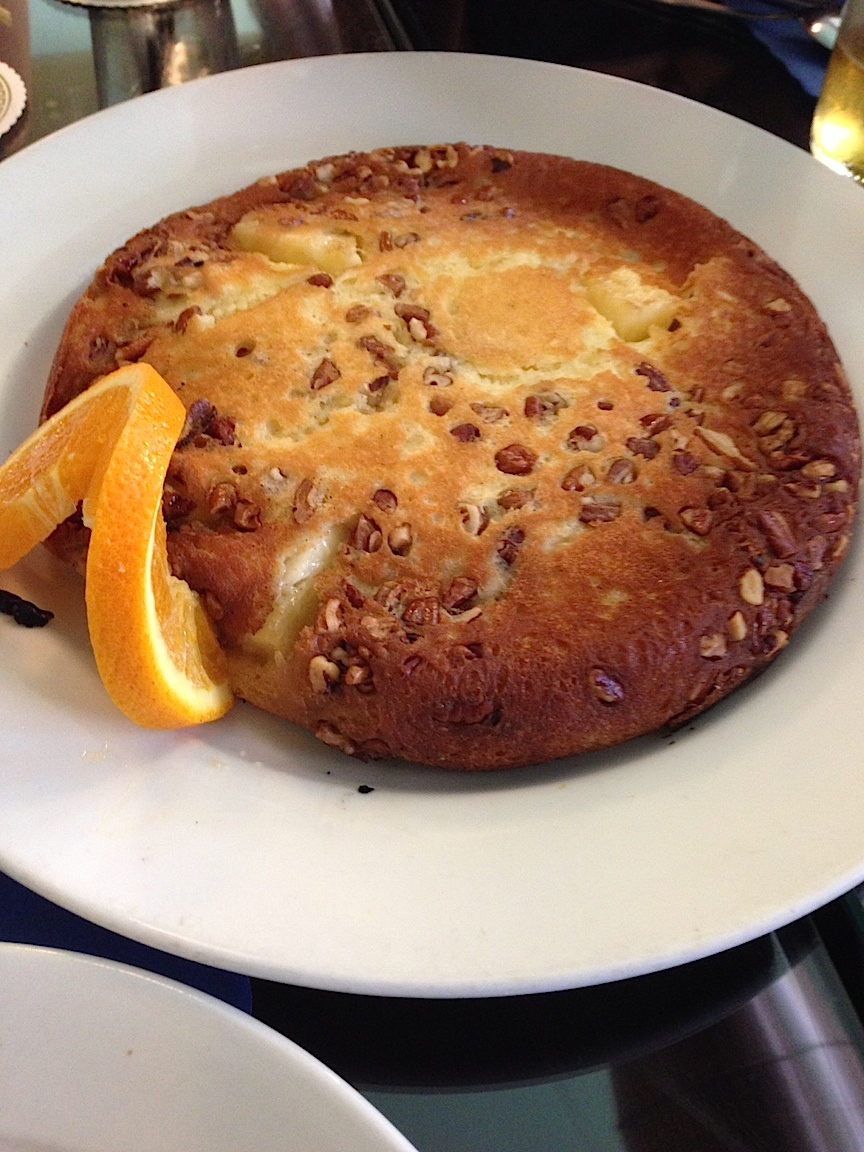
You can build your own omelet ($14-$16), and,
this being the South, they make big, beautiful
biscuits covered with pork sausage gravy; and this
being Florida, they serve oven-baked mahi fillet
with eggs, Yukon gold potatoes, and cheese grits on
toast ($15). You
can bank on the mahi being unstintingly fresh, the
potatoes buttery, and the grits glistening hot from
the pot on toast made from good bread.
O-B is an original, and I’m glad Eli hasn’t cloned
it. For, even if the food were as good, nothing else
would be quite the same.
Oh, and Eli’s playlist of the best songs of the ‘60s
and ‘70s, played softly, makes a breakfast here like
a breakfast at home when you’ve got your favorite
station on the old transistor radio.
I
cannot fail to report on one of the most admirable
labors of love I’ve ever run across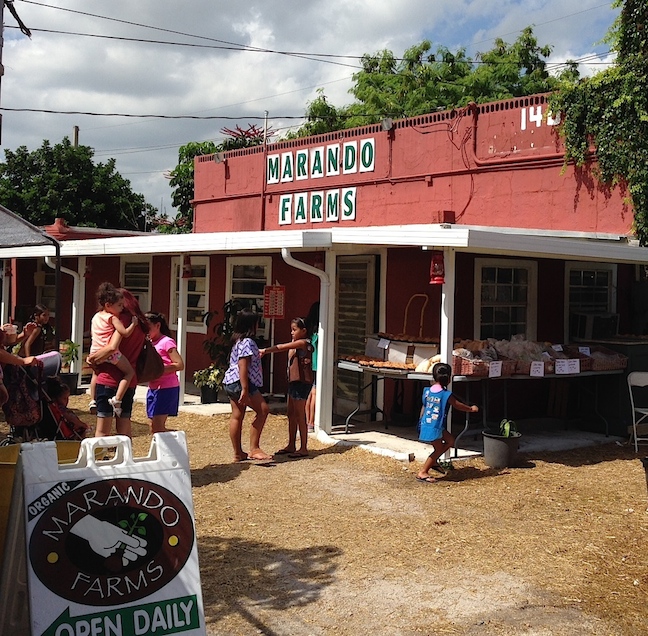 —Marando
Farms, a small acre or two of market,
hydroponic agriculture, free-ranging roosters and
chickens, and a great deal more, owned and run by
two young people, Chelsea and Fred Marando, who grew
up on a farm and have dedicated themselves to
running theirs in order to promote healthful farming
practices among small farms.
—Marando
Farms, a small acre or two of market,
hydroponic agriculture, free-ranging roosters and
chickens, and a great deal more, owned and run by
two young people, Chelsea and Fred Marando, who grew
up on a farm and have dedicated themselves to
running theirs in order to promote healthful farming
practices among small farms.
To
that end, they
have helped several local farmers from going out of
business, asked them to raise special sustainable
crops, buy the most delicious unpasteurized dairy
products (the labels read “For animal consumption,”
but humans will qualify), and infuse the entire
enterprise with their own huge enthusiasm. It was
not just a pleasure meeting and talking with
Chelsea; it was an honor and an education for me.
The more places like this appear
within cities everywhere, the better and fresher and
more natural our food will be, and I believe it is
as requisite to bring children to farms like this as
it is to museums and arts venues. Chelsea told
me her kids never get sick, so let tours roll around
in the dirt at a place like Marando's and they'll
grow up healthier and wiser.
❖❖❖
By John Mariani

461 West 23rd Street
212-255-7400
www.barchettanyc.com
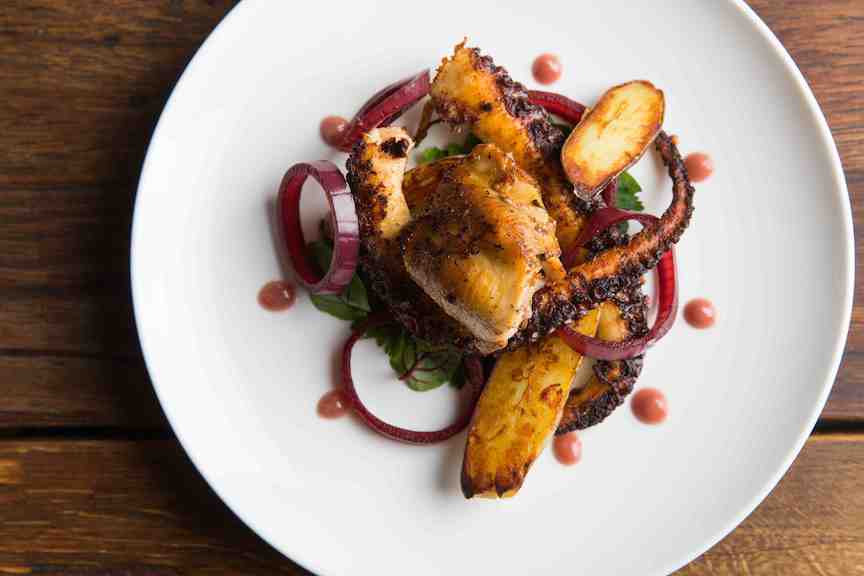 Hard
to believe Chef David Pasternack opened the West
Side seafood restaurant Esca fourteen years ago
and that it is still going strong for its
deceptively simple preparations with an Italian
component. Now,
with the opening of Barchetta (“little boat”) with
partner John Meadow of LDV Hospitality, he moves
the marker closer to the Italian Mediterranean.
Hard
to believe Chef David Pasternack opened the West
Side seafood restaurant Esca fourteen years ago
and that it is still going strong for its
deceptively simple preparations with an Italian
component. Now,
with the opening of Barchetta (“little boat”) with
partner John Meadow of LDV Hospitality, he moves
the marker closer to the Italian Mediterranean.
The two rooms’ décor is
more rustic than Esca’s and a mix of white oak
wooden tables from a 19th
century barn, 1950s Danish modern school chairs,
and Chelsea artists’ work, along with low lighting
(the photo below is daytime) and a decent sound
level make this an easy place to go with friends. 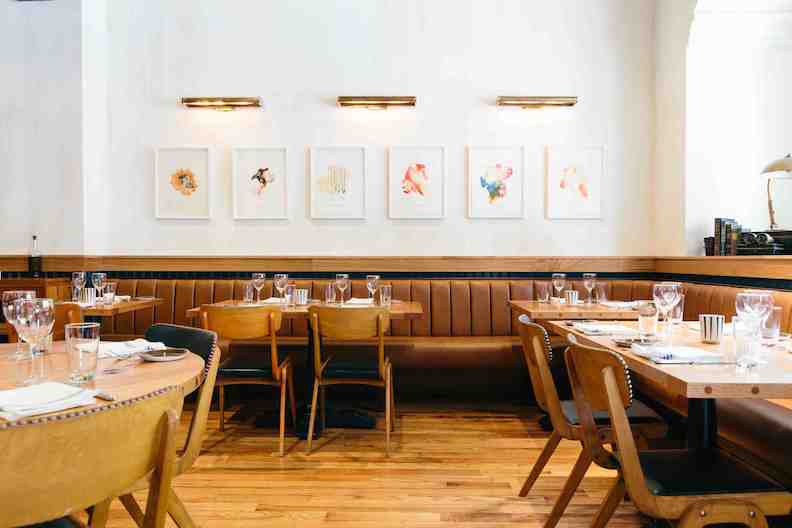
By all means start with the crudi,
raw
fish of a kind Pasternack was among the first to
bring to New York. They are pristine examples of
the day’s market offerings, best appreciated in a
tasting of six, in two flights ($28), which may
include vermillion snapper, mahi mahi, red
albacore, bluefish, and oysters.
The antipasti
range from crisply fried bianchette
($16), little silver fish you eat like French
fries, to raw baccalà ($18), made from
Spanish salt cod—and the salt was
overpowering—with delicious wild mushrooms and
watercress.
Primi are pasta dishes, which were
surprisingly not winners: ravioli puttanesca’s
spicy tomato and saffron ($22) wiped out the
flavor of the tuna belly, and tasty bavette
noodles ($23) had very little of the jumbo lump
crab meat promised, with wild onion flowers and
toasted breadcrumbs.
The main seafood courses were all as expected from
the man who wrote the fine cookbook Young
Man and the Sea (2007): true Scottish salmon,
velvety and light in flavor came with wild arugula
and pine nut pesto ($26), while a blackened
kingfish steak with succotash ($27) had real gusto
to it. Orata
(sea bream) comes whole, with capers and rosemary
($28), 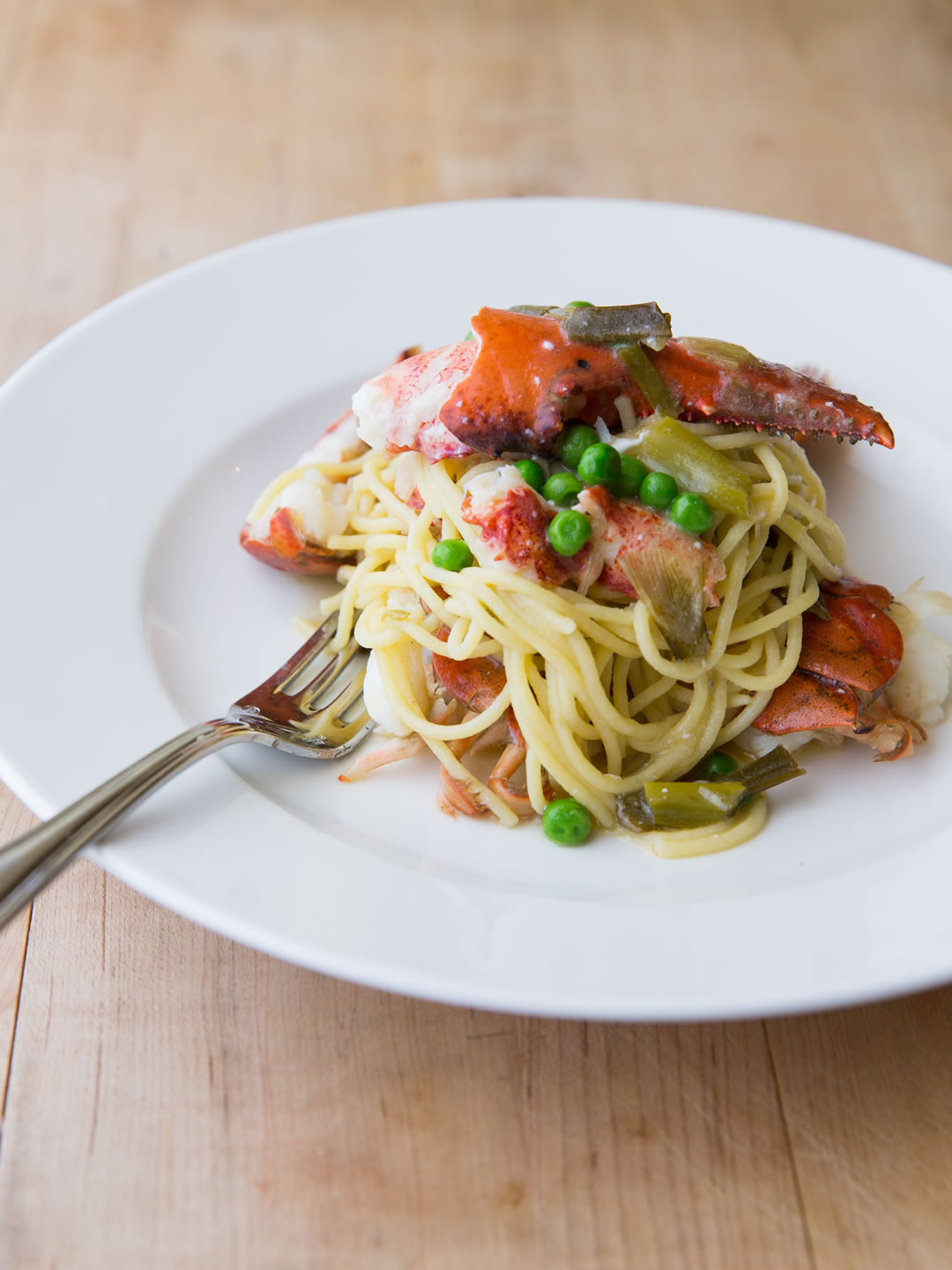 exactly as you’d have it at
a trattoria on Capri, and spigola nero
($28), black
bass, was just as simply—and admirably--done, with
crispy potatoes.
exactly as you’d have it at
a trattoria on Capri, and spigola nero
($28), black
bass, was just as simply—and admirably--done, with
crispy potatoes.
There are also three non-seafood dishes on the
menu.
For dessert I loved the almond
tart with yellow peaches; a budino
chocolate cake with pink peppercorns and
tequila-laced cream, a fruit crostata
with vanilla gelato;
and a butter cream caramel gelato
with sesame brittle (all $12).
I find the prices at Barchetta remarkably modest
considering the quality of seafood served, and it
is to Pasternack’s credit that his long
familiarity with the mongers rewards him and his
guests with first quality ingredients.
Dinner is
served nightly.
❖❖❖
By John Mariani
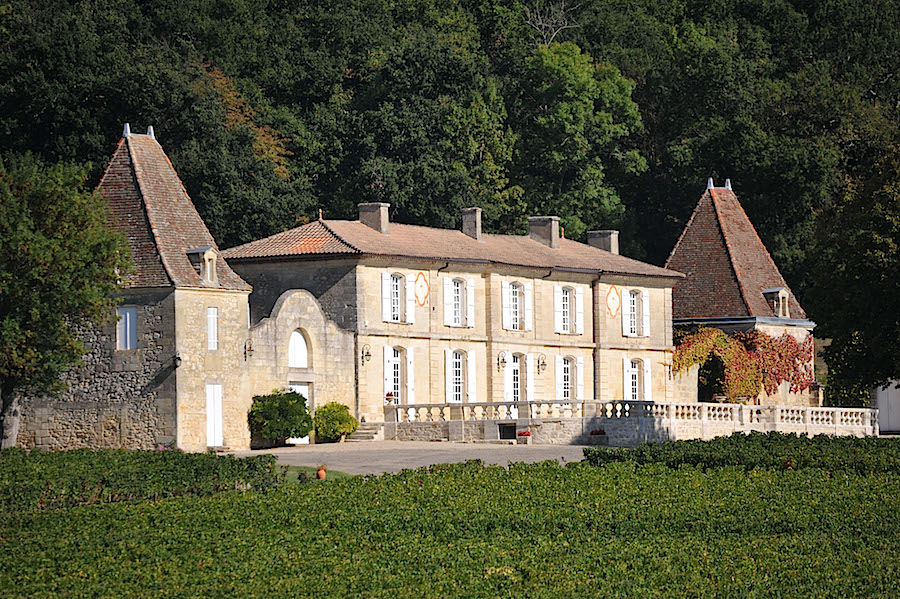
Château Lassègue
If, as
I do, you drink wine every day of your life, the
number of outstanding bottlings versus the
decent, drinkable ones and the ones poured down
the drain is fairly small. But
when one of those outstanding bottles comes
along—and they are not always the priciest of
wines—they are often a reminder of something
fundamental about wine, something you might have
discovered when you drank your first great wine
long ago.
This
wonderment was brought into sharp focus the
other night when I poured a 2005 Château
Lassègue Grand Cru Saint-Émilion
($150), an  estate on the Dordogne
River’s Right Bank (left), near the
pretty town of Libourne.
estate on the Dordogne
River’s Right Bank (left), near the
pretty town of Libourne.
I chose it to
accompany a grilled veal chop, and from the
first sip I was set back on my chair, almost
wistfully, because I knew I was drinking not
just a great red wine but one that is as
expressive as any in Bordeaux of a varietal
flavor, complexity, and the beneficent workings
of climate, soil and time.
It reminded me of the time, back in 1967, when a
college friend and I pooled our resources to by
a bottle of Lafite-Rothschild for seven dollars,
then a not paltry amount of money for a red
wine. I
remember clearly that I was tasting something I
had never tasted before, a wine that summed up
what wine truly is—a confluence of natural and
human factors and the coincidence of the right
winemaker being at the right terroir.
The Lassègue was like that, a
quintessential Bordeaux, the kind of wine that
defines not just a region but a standard for
cabernet sauvignon-based blends. The
binding tannins had loosened, the merlot had
done its softening work, and the other grapes
brought nuance in every sip. This
is what a red wine should taste like—not a fruit
bomb, not a massive, tannic explosion, not a
high alcohol wine made solely to win beauty
contests.
The estate, dominated by a 17th
century chateau, is very old but had gone into
some decline before Americans Barbara Banke and
the late Jess Jackson, along with Pierre and Monique
Seillan, bought these 60 acres of
south-southwest-facing vineyards. They
took a decade to restore the château’s
architecture while pouring money into reviving
the vineyards, implementing new trellising,
drainage, cover crops, state-of-the-art
equipment, and new cellars for aging the wines.
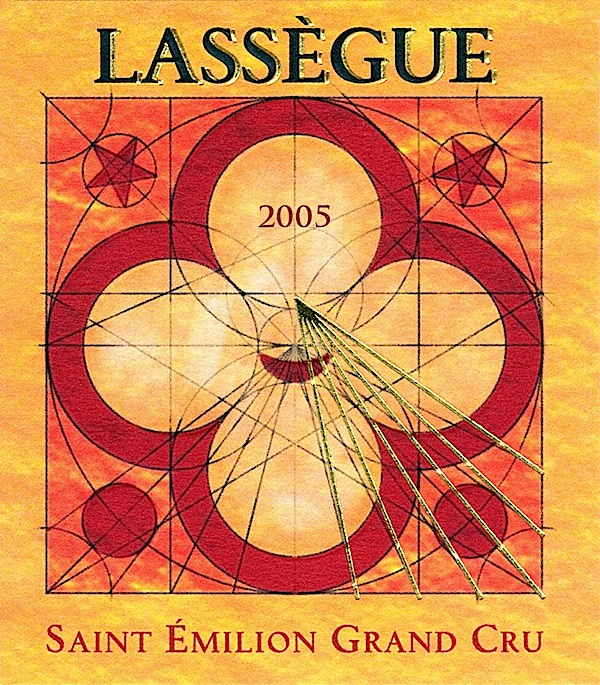
Seillan,
a Gascon, also put into action his “micro-cru”
philosophy, by which each vineyard block is
divided into small micro-crus according to soil
types and terroir. Seillan even handpicks the
oak trees from 15 specific forests to craft his
aging barrels. The
estate’s vines average from forty to fifty years
old, with a yield no more than thirty-five
hectoliters of fruit per hectare.
I asked Seillan (below) some questions that will affect the Bordeaux wine market in the future.
1. Is there much flux on Bordeaux at this time
in terms of winemaking techniques?
The evolution of
viticulture is more evident than in winemaking.
Today, we have a better selection in the
vineyards, because we are all selecting out the
clusters. As a whole we are no longer
pushing production and are focused on lower
yields and better quality. For instance,
we may employ early leaf-pulling after bloom, to
improve the ripening of the crop
2. Has the effect of global
warming caused any changes in the terroir thus
far?
Because of global
warming, the brix is higher so there is no
longer the need for chaptalization. But
if global warming continues over the next 30
years, we will see changes in the terroir.
It is important to note that in
Bordeaux we would have a terrible time dealing
with the effect of global 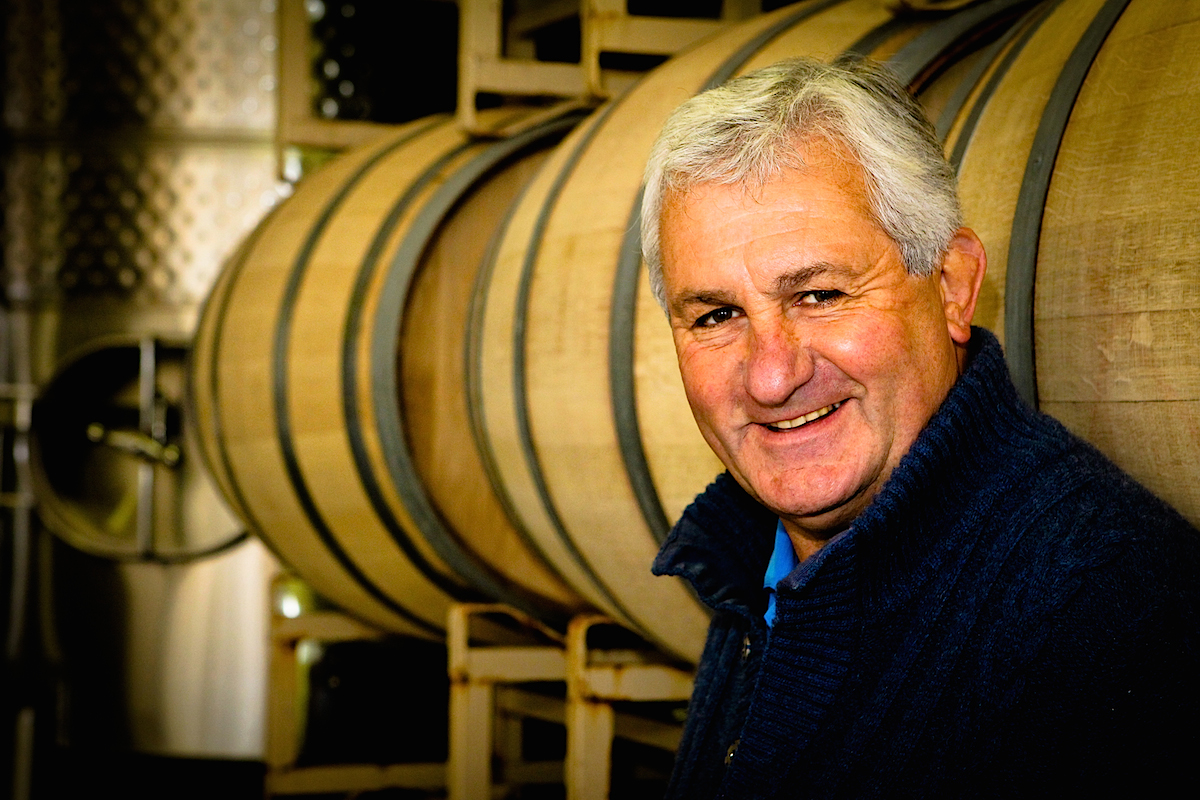 warming—the
driest terroirs would be in critical condition,
and we would have to reconsider techniques like
irrigation similar to California.
warming—the
driest terroirs would be in critical condition,
and we would have to reconsider techniques like
irrigation similar to California.
3. Is Bordeaux trying to keep its prices as
competitive as possible in the current global
market?
This totally depends on the nature of the wines: simple Bordeaux or first growths? Top growths have an unpredictable pricing attitude. About 5 percent of the production in Bordeaux is classified as First Growths, and the pricing is always led by this group. Of course, many factors go into the pricing: quality of the vintage, then currency rates, the international demand, and the opinion of the most influential media.
4. Does China seem to be a future market for his wines or do they only want to buy the Premier Crus?
Absolutely, this is a market that is interested in our wines. Right now Château Lassègue does not have distribution, but we have had success in the past with Vérité. As China progresses and develops as a market we expect to see the potential and interest increase.
❖❖❖
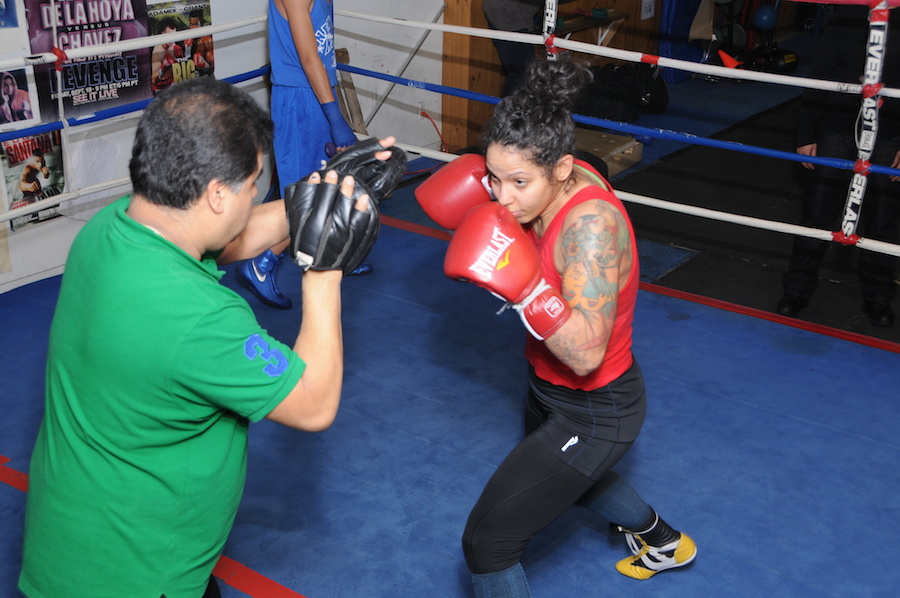
AN ARTICLE ON ARUBA
“We
had
been in the lobby of our hotel in Oranjestad,
Aruba’s capital, for only a few minutes when the
Dutch territory’s Arcadian `One Happy Island’ front
was shattered by a desk clerk whose petulance hit me
like a left hook straight to the temple. As she
delivered the rules and regulations like a stern
lecture, scolding my daughter and me for the simple
offense of standing before her, my mind drifted back
home to New York City. There I was, at Mendez Boxing
gym, and there she was, standing in place of my
favorite heavy bag.”—Raquel Cepeda, “On an
Island Hunt for Pieces of My History,” NY Times
(Aug 17, 2014).
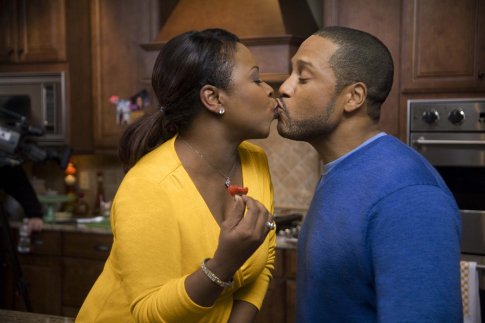
YOU MEAN ALL THAT
“SWEETIE, HONEY, BABY,
OO-EE!" BANTER ON THE SHOW WASN’T
REAL?
Gina
and Pat Neely, the hosts of the Food Network's "Down
Home With the Neelys" and owners of Neely's Barbecue
Parlor in NYC, the
Upper East Side, announced that they will divorce
after 20 years of marriage.
People reported
the pair's split by noting that in the past year
Gina went on the "weight-loss challenge" sponsored
by George Foreman Grill, while Pat did food and
cooking videos with Family Dollar.
A BIG ANNOUNCEMENT!
 I'm proud and happy to
announce that my new book, The
Hound in Heaven (21st Century Lion Books),
has just been published through Amazon
and Kindle. It is a Christmas novella, and
for anyone who loves dogs, Christmas, romance,
inspiration, even the supernatural, I hope you'll find
this to be a treasured favorite. The story
concerns how, after a New England teacher, his wife and
their two daughters adopt a stray puppy found in their
barn in northern Maine, their lives seem full of
promise. But when tragedy strikes, their wonderful dog
Lazarus and the spirit of Christmas are the only things
that may bring back his master back from the edge of
despair.
I'm proud and happy to
announce that my new book, The
Hound in Heaven (21st Century Lion Books),
has just been published through Amazon
and Kindle. It is a Christmas novella, and
for anyone who loves dogs, Christmas, romance,
inspiration, even the supernatural, I hope you'll find
this to be a treasured favorite. The story
concerns how, after a New England teacher, his wife and
their two daughters adopt a stray puppy found in their
barn in northern Maine, their lives seem full of
promise. But when tragedy strikes, their wonderful dog
Lazarus and the spirit of Christmas are the only things
that may bring back his master back from the edge of
despair. “What a huge surprise turn this story took! I was completely stunned! I truly enjoyed this book and its message.” – Actress Ali MacGraw
“He had me at Page One. The amount of heart, human insight, soul searching, and deft literary strength that John Mariani pours into this airtight novella is vertigo-inducing. Perhaps ‘wow’ would be the best comment.” – James Dalessandro, author of Bohemian Heart and 1906.
“John Mariani’s Hound in Heaven starts with a well-painted portrayal of an American family, along with the requisite dog. A surprise event flips the action of the novel and captures us for a voyage leading to a hopeful and heart-warming message. A page turning, one sitting read, it’s the perfect antidote for the winter and promotion of holiday celebration.” – Ann Pearlman, author of The Christmas Cookie Club and A Gift for my Sister.
“John Mariani’s concise, achingly beautiful novella pulls a literary rabbit out of a hat – a mash-up of the cosmic and the intimate, the tragic and the heart-warming – a Christmas tale for all ages, and all faiths. Read it to your children, read it to yourself… but read it. Early and often. Highly recommended.” – Jay Bonansinga, New York Times bestselling author of Pinkerton’s War, The Sinking of The Eastland, and The Walking Dead: The Road To Woodbury.
“Amazing things happen when you open your heart to an animal. The Hound in Heaven delivers a powerful story of healing that is forged in the spiritual relationship between a man and his best friend. The book brings a message of hope that can enrich our images of family, love, and loss.” – Dr. Barbara Royal, author of The Royal Treatment.
Any of John Mariani's books below may be ordered from amazon.com.
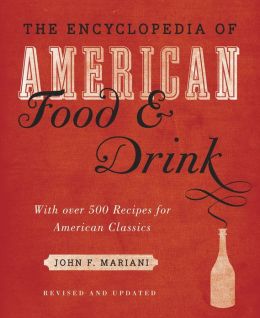 |
The Encyclopedia of American Food and Drink by John F. Mariani (Bloomsbury USA, $35) Modesty forbids me to praise my own new book, but let me proudly say that it is an extensive revision of the 4th edition that appeared more than a decade ago, before locavores, molecular cuisine, modernist cuisine, the Food Network and so much more, now included. Word origins have been completely updated, as have per capita consumption and production stats. Most important, for the first time since publication in the 1980s, the book includes more than 100 biographies of Americans who have changed the way we cook, eat and drink -- from Fannie Farmer and Julia Child to Robert Mondavi and Thomas Keller. "This book is amazing! It has entries for everything from `abalone' to `zwieback,' plus more than 500 recipes for classic American dishes and drinks."--Devra First, The Boston Globe. "Much needed in any kitchen library."--Bon Appetit. |
"Eating Italian will never be the same after reading John Mariani's entertaining and savory gastronomical history of the cuisine of Italy and how it won over appetites worldwide. . . . This book is such a tasteful narrative that it will literally make you hungry for Italian food and arouse your appetite for gastronomical history."--Don Oldenburg, USA Today. "Italian
restaurants--some good, some glitzy--far
outnumber their French rivals. Many of
these establishments are zestfully described
in How Italian Food Conquered the World, an
entertaining and fact-filled chronicle by
food-and-wine correspondent John F.
Mariani."--Aram Bakshian Jr., Wall Street
Journal.
"Equal parts
history, sociology, gastronomy, and just
plain fun, How Italian Food Conquered the
World tells the captivating and delicious
story of the (let's face it) everybody's
favorite cuisine with clarity, verve and
more than one surprise."--Colman Andrews,
editorial director of The Daily
Meal.com. "A fantastic and fascinating
read, covering everything from the influence
of Venice's spice trade to the impact of
Italian immigrants in America and the
evolution of alta cucina. This book will
serve as a terrific resource to anyone
interested in the real story of Italian
food."--Mary Ann Esposito, host of PBS-TV's
Ciao
Italia. "John Mariani has written the
definitive history of how Italians won their
way into our hearts, minds, and
stomachs. It's a story of pleasure over
pomp and taste over technique."--Danny Meyer,
owner of NYC restaurants Union Square
Cafe, The Modern, and Maialino.
|
 |
 |
 |
 |
 |
 |
 |
 |
 Everett Potter's Travel Report:
Everett Potter's Travel Report: 
 Eating Las Vegas
is the new on-line site for Virtual Gourmet
contributor John A. Curtas., who since 1995
has been commenting on the Las Vegas food
scene and reviewing restaurants for Nevada
Public Radio. He is also the
restaurant critic for KLAS TV, Channel 8 in
Las Vegas, and his past reviews can be
accessed at KNPR.org.
Click on the logo below to go directly to
his site.
Eating Las Vegas
is the new on-line site for Virtual Gourmet
contributor John A. Curtas., who since 1995
has been commenting on the Las Vegas food
scene and reviewing restaurants for Nevada
Public Radio. He is also the
restaurant critic for KLAS TV, Channel 8 in
Las Vegas, and his past reviews can be
accessed at KNPR.org.
Click on the logo below to go directly to
his site.

Tennis Resorts Online: A Critical Guide to the World's Best Tennis Resorts and Tennis Camps, published by ROGER COX, who has spent more than two decades writing about tennis travel, including a 17-year stretch for Tennis magazine. He has also written for Arthur Frommer's Budget Travel, New York Magazine, Travel & Leisure, Esquire, Money, USTA Magazine, Men's Journal, and The Robb Report. He has authored two books-The World's Best Tennis Vacations (Stephen Greene Press/Viking Penguin, 1990) and The Best Places to Stay in the Rockies (Houghton Mifflin, 1992 & 1994), and the Melbourne (Australia) chapter to the Wall Street Journal Business Guide to Cities of the Pacific Rim (Fodor's Travel Guides, 1991).


MARIANI'S VIRTUAL GOURMET
NEWSLETTER is published weekly. Editor/Publisher: John
Mariani.
Editor: Walter Bagley. Contributing Writers: Christopher Mariani,
Robert Mariani, Misha
Mariani,
John A. Curtas, Edward Brivio, Mort Hochstein,
Andrew Chalk, Dotty Griffith and Brian Freedman. Contributing
Photographers: Galina Dargery, Bobby
Pirillo. Technical Advisor: Gerry McLoughlin.
To un-subscribe from this newsletter,click here.
© copyright John Mariani 2014
